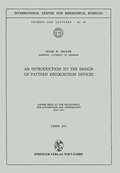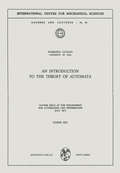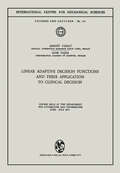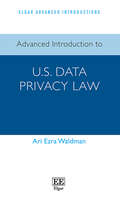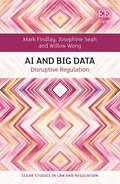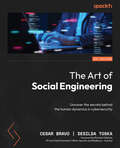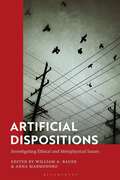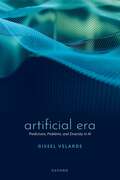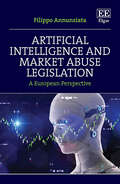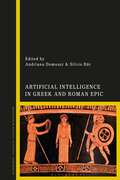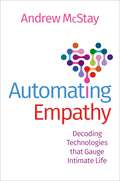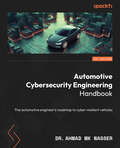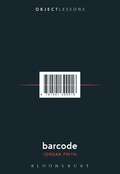- Table View
- List View
An Introduction to the Design of Pattern Recognition Devices (CISM International Centre for Mechanical Sciences #83)
by P.W. BeckerAn Introduction to the Theory of Automata: Course Held at the Department for Automation and Information July 1971 (CISM International Centre for Mechanical Sciences #88)
by Fabrizio LuccioLinear Adaptive Decision Functions and Their Application to Clinical Decision: Course held at the Department for Automation and Information, June - July 1971 (CISM International Centre for Mechanical Sciences #114)
by Arnost Vesely Igor VajdaMathematical Structure of Finite Random Cybernetic Systems: Lectures Held at the Department for Automation and Information July 1971 (CISM International Centre for Mechanical Sciences #86)
by Silviu GuiasuMathematische Grundlagen der Quantenmechanik (Grundlehren der mathematischen Wissenschaften #38)
by Johann v. NeumannParaphrase Grammars (Formal Linguistics Series #2)
by R.M. SmabyThe recent rapid development of transformational grammars has incorpo rated some strong claims in the areas of semantics and co-occurrence. The earlier structuralists relied on a minimum of information about the meaning of strings of a language. They asked only if strings of sounds were different in meaning - or simply were different words or phrases. Current transfor mational grammars, on the other hand, set as their goal the production of exactly the meaningful strings of a language. Stated slightly differently, they wish to specify exactly which strings of a language can occur together (meaningfully) in a given order. The present book purports to show that transformational grammar is in dependent of the current trends in semantics. I claim that exciting and sophisticated transformational grammars are required for describing when strings of a language mean the same, that is, for describing when strings of a language are paraphrases of each other. This task can be quite naturally limited to a project of much weaker semantic claims than those which are current in transformational linguistics.
Pattern Recognition and Machine Learning: Proceedings of the Japan—U.S. Seminar on the Learning Process in Control Systems, held in Nagoya, Japan August 18–20, 1970
by King-Sun FuThis book contains the Proceedings of the US-Japan Seminar on Learning Process in Control Systems. The seminar, held in Nagoya, Japan, from August 18 to 20, 1970, was sponsored by the US-Japan Cooperative Science Program, jointly supported by the National Science Foundation and the Japan Society for the Promotion of Science. The full texts of all the presented papers except two t are included. The papers cover a great variety of topics related to learning processes and systems, ranging from pattern recognition to systems identification, from learning control to biological modelling. In order to reflect the actual content of the book, the present title was selected. All the twenty-eight papers are roughly divided into two parts--Pattern Recognition and System Identification and Learning Process and Learning Control. It is sometimes quite obvious that some papers can be classified into either part. The choice in these cases was strictly the editor's in order to keep a certain balance between the two parts. During the past decade there has been a considerable growth of interest in problems of pattern recognition and machine learn ing. In designing an optimal pattern recognition or control system, if all the a priori information about the process under study is known and can be described deterministically, the optimal system is usually designed by deterministic optimization techniques.
Advanced Introduction to U.S. Data Privacy Law (Elgar Advanced Introductions series)
by Ari E. WaldmanElgar Advanced Introductions are stimulating and thoughtful introductions to major fields in the social sciences, business and law, expertly written by the world’s leading scholars. Designed to be accessible yet rigorous, they offer concise and lucid surveys of the substantive and policy issues associated with discrete subject areas.This timely Advanced Introduction traces the evolution of consumer data privacy laws in the US through a historical lens, and then sets out the current state of play. Waldman describes how privacy laws benefit corporate interests, and highlights the deficiencies of the present approach to the surveillance economy. In looking to the future, the author advocates a radical new way of thinking about the goals and tools of privacy law and provides a roadmap for avoiding privacy nihilism by rejuvenating public governance and protecting privacy in the digital age.Key Features:Concise and accessible approach to a fast-changing areaNovel conceptualisation of first, second, and third waves of privacy lawIn-depth critique of current and historic privacy law, challenging traditional literatureFocuses on practical ways to address.– deficiencies of current lawsThe Advanced Introduction to U.S. Data Privacy Law will be an invaluable resource for students and scholars of privacy, as well as those in information, media and technology law. It will also be an essential guide for policy-makers and privacy lawyers seeking to understand the past, present, and future of data privacy.
AI and Big Data: Disruptive Regulation (Elgar Studies in Law and Regulation)
by Mark Findlay Josephine Seah Willow WongThis provocative and timely book identifies and disrupts the conventional regulation and governance discourses concerning AI and big data. It suggests that, instead of being used as tools for exclusionist commercial markets, AI and big data can be employed in governing digital transformation for social good. Analysing the ways in which global technology companies have colonised data access, the book reveals how trust, ethics, and digital self-determination can be reconsidered and engaged to promote the interests of marginalised stakeholders in data arrangement. Chapters examine the regulation of labour engagement in digital economies, the landscape of AI ethics, and a multitude of questions regarding participation, costs, and sustainability. Presenting several informative case studies, the book challenges some of the accepted qualifiers of frontier tech and data use and proposes innovative ways of actioning the more conventional regulatory components of big data. Scholars and students in information and media law, regulation and governance, and law and politics will find this book to be critical reading. It will also be of interest to policymakers and the AI and data science community.
Alfredo Roces: Digital Paintings
Alfredo Roces: Digital Paintings features the digital art creation of a polymathic Filipino artist. Though formally trained in the traditional school of fine arts—where in the mid-fifties, the artist took up drawing classes with German Expressionist and Dadaist, George Grosz at the Art Students League of New York—Roces welcomed with gusto the offer of new technologies for his artmaking. The artist’s encounter with “Photoshop” in 2004 would eventually set the stage for his ongoing adventures with digital artmaking—when in 2011, nearing eighty years of age, he discovered the Big Apple and found his Eden with “Brushes” (and later on, “Procreate”) in iPad. The book presents a selection of more than a hundred of Roces’s iPad drawings in various genres—portrait, still life, human figure, and abstract—and shows to full effect the artist’s zest for life. The book is prologued with an interview with the editor, David Jonathan Bayot, in which Roces tells of a life so far and speaks of his dreams for the tomorrows ahead. A prefatory interview is complemented by the artist’s own account of his “adventures with digital art.” In the words of Tina Colayco, President of the Metropolitan Museum of Manila: "There is much to be admired with Alfredo Roces who at 90 remains an authentic and authoritative persona in Philippine art and culture. The book captures the essence of Roces as a Filipino artist, the zeitgeist of so many decades, and a continuing passion to create art. It brings to the fore the journey of the gentleman-artist described in the epigraph to the book as ‘sitting in the Row of a morning’.”
The Architecture of Open Source Applications: Elegance, Evolution, and a Few Fearless Hacks
by Amy Brown Greg WilsonArchitects look at thousands of buildings during their training, and study critiques of those buildings written by masters. In contrast, most software developers only ever get to know a handful of large programs well—usually programs they wrote themselves—and never study the great programs of history. As a result, they repeat one another's mistakes rather than building on one another's successes. Our goal is to change that. In these two books, the authors of four dozen open source applications explain how their software is structured, and why. What are each program's major components? How do they interact? And what did their builders learn during their development? In answering these questions, the contributors to these books provide unique insights into how they think. If you are a junior developer, and want to learn how your more experienced colleagues think, these books are the place to start. If you are an intermediate or senior developer, and want to see how your peers have solved hard design problems, these books can help you too.
The Art of Social Engineering: Uncover the secrets behind the human dynamics in cybersecurity
by Cesar Bravo Desilda ToskaUnderstand psychology-driven social engineering, arm yourself with potent strategies, and mitigate threats to your organization and personal data with this all-encompassing guideKey FeaturesGain insights into the open source intelligence (OSINT) methods used by attackers to harvest dataUnderstand the evolving implications of social engineering on social networksImplement effective defensive strategies to mitigate the probability and impact of social engineering attacksPurchase of the print or Kindle book includes a free PDF eBookBook DescriptionSocial engineering is one of the most prevalent methods used by attackers to steal data and resources from individuals, companies, and even government entities. This book serves as a comprehensive guide to understanding social engineering attacks and how to protect against them. The Art of Social Engineering starts by giving you an overview of the current cyber threat landscape, explaining the psychological techniques involved in social engineering attacks, and then takes you through examples to demonstrate how to identify those attacks. You’ll learn the most intriguing psychological principles exploited by attackers, including influence, manipulation, rapport, persuasion, and empathy, and gain insights into how attackers leverage technology to enhance their attacks using fake logins, email impersonation, fake updates, and executing attacks through social media. This book will equip you with the skills to develop your own defensive strategy, including awareness campaigns, phishing campaigns, cybersecurity training, and a variety of tools and techniques. By the end of this social engineering book, you’ll be proficient in identifying cyberattacks and safeguarding against the ever-growing threat of social engineering with your defensive arsenal.What you will learnGrasp the psychological concepts and principles used in social engineering attacksDistinguish the different types of social engineering attacksExamine the impact of social engineering on social networksFind out how attackers leverage OSINT tools to perform more successful attacksWalk through the social engineering lifecycleGet a glimpse of the capabilities of Social Engineering Toolkit (SET)Who this book is forThis book is for cybersecurity enthusiasts, ethical hackers, penetration testers, IT administrators, cybersecurity analysts, or anyone concerned with cybersecurity, privacy, and risk management. It will serve as a valuable resource for managers, decision makers, and government officials to understand the impact and importance of social engineering and how to protect against this threat.
Artificial Dispositions: Investigating Ethical and Metaphysical Issues
We inhabit a world not only full of natural dispositions independent of human design, but also artificial dispositions created by our technological prowess. How do these dispositions, found in automation, computation, and artificial intelligence applications, differ metaphysically from their natural counterparts? This collection investigates artificial dispositions: what they are, the roles they play in artificial systems, and how they impact our understanding of the nature of reality, the structure of minds, and the ethics of emerging technologies. It is divided into four parts covering the following interconnected themes: (i) Artificial and Natural Dispositions, (ii) Artificial Systems and Their Dispositions, (iii) Agency, Mind, and Artificial Dispositions, and (iv) Artificial Moral Dispositions. This is a groundbreaking and thought-provoking resource for any student or scholar of philosophy of science, contemporary metaphysics, applied ethics, philosophy of mind, and philosophy of technology.
Artificial Era: Predictions, Problems, and Diversity in AI
by Gissel VelardePresenting a ground-breaking view of technology trends and their impact on our society, Artificial Era contributes to the current debate about the consequences of technological innovations. Alongside different viewpoints and statistics on the use of robots worldwide, productivity, and job displacement, Gissel Velarde identifies the particular problem of the lack of diversity in AI communities - and how that can exacerbate representation issues in employment, civil rights, gender, and education if no actions are taken. A timely, inciteful book which will be required reading for scholars and professionals working with AI and automation, and leaders in business and government interested in better understanding it and its effects on business and society.
Artificial Intelligence and Market Abuse Legislation: A European Perspective
by Filippo AnnunziataArtificial Intelligence and Market Abuse Legislation presents a wide-reaching interdisciplinary examination of the impact of AI on the EU Market Abuse Regulation (MAR).Assessing the principles and rules governing the MAR disclosure regime as well as the mechanisms of market manipulation, Filippo Annunziata examines the important role of AI systems in the prompt disclosure of inside trading information. The author analyses the threat of breaches in disclosure protocol posed by technological malfunctions, as well as the opportunities and drawbacks presented by market manipulation in algorithmic trading. This incisive book goes on to argue for greater trading venue monitoring and the installation of adequate systems that can analyse, predict and thus anticipate situations that result in market manipulation.A state-of-the-art study analysing the impact of AI in relation to MAR from both a disclosure regime and an algorithmic trading perspective, this book will be critical reading for researchers interested in the law on AI, and in the regulation of global financial trading and market regulation. It will also be of interest to practitioners and policymakers working in the global financial sector.
Artificial Intelligence in Greek and Roman Epic
This is the first scholarly exploration of concepts and representations of Artificial Intelligence in ancient Greek and Roman epic, including their reception in later literature and culture. Contributors look at how Hesiod, Homer, Apollonius of Rhodes, Moschus, Ovid and Valerius Flaccus crafted the first literary concepts concerned with automata and the quest for artificial life, as well as technological intervention improving human life.Parts one and two consider, respectively, archaic Greek, and Hellenistic and Roman, epics. Contributors explore the representations of Pandora in Hesiod, and Homeric automata such as Hephaestus' wheeled tripods, the Phaeacian king Alcinous' golden and silver guard dogs, and even the Trojan Horse. Later examples cover Artificial Intelligence and automation (including Talos) in the Argonautica of Apollonius and Valerius Flaccus, and Pygmalion's ivory woman in Ovid's Metamorphoses. Part three underlines how these concepts benefit from analysis of the ekphrasis device, within which they often feature. These chapters investigate the cyborg potential of the epic hero and the literary implications of ancient technology. Moving into contemporary examples, the final chapters consider the reception of ancient literary Artificial Intelligence in contemporary film and literature, such as the Czech science-fiction epic Starvoyage, or Small Cosmic Odyssey by Jan Kr?esadlo (1995) and the British science-fiction novel The Holy Machine by Chris Beckett (2004).
Automating Empathy: Decoding Technologies that Gauge Intimate Life
by Andrew McStayThis is an open access title. It is made available under a Creative Commons Attribution-Non Commercial-No Derivatives 4.0 International license. It is available to read and download as a PDF version on the Oxford Academic platform. We live in a world where artificial intelligence and intensive use of personal data has become normalized. Companies across the world are developing and launching technologies to infer and interact with emotions, mental states, and human conditions. However, the methods and means of mediating information about people and their emotional states are incomplete and problematic. Automating Empathy offers a critical exploration of technologies that sense intimate dimensions of human life and the modern ethical questions raised by attempts to perform and simulate empathy. It traces the ascendance of empathic technologies from their origins in physiognomy and pathognomy to the modern day and explores technologies in nations with non-Western ethical histories and approaches to emotion, such as Japan. The book examines applications of empathic technologies across sectors such as education, policing, and transportation, and considers key questions of everyday use such as the integration of human-state sensing in mixed reality, the use of neurotechnologies, and the moral limits of using data gleaned through automated empathy. Ultimately, Automating Empathy outlines the key principles necessary to usher in a future where automated empathy can serve and do good. Drawing insights across ethics, philosophy, and policy, Automating Empathy argues for a pluralistic reconceptualization of empathic technologies to better reflect the intimate dimensions of human life.
Automotive Cybersecurity Engineering Handbook: The automotive engineer's roadmap to cyber-resilient vehicles
by Dr. Ahmad NasserAccelerate your journey of securing safety-critical automotive systems through practical and standard-compliant methodsKey FeaturesUnderstand how automotive systems can become vulnerable to cyberattacksApply security controls to all vehicle layers for mitigating cybersecurity risksFind out how systematic secure engineering mitigates cyber risks while ensuring compliancePurchase of the print or Kindle book includes a free PDF eBookBook DescriptionReplete with exciting challenges, automotive cybersecurity is an emerging domain, and cybersecurity is a foundational enabler for current and future connected vehicle features. This book addresses the severe talent shortage faced by the industry in meeting the demand for building cyber-resilient systems by consolidating practical topics on securing automotive systems to help automotive engineers gain a competitive edge. The book begins by exploring present and future automotive vehicle architectures, along with relevant threats and the skills essential to addressing them. You’ll then explore cybersecurity engineering methods, focusing on compliance with existing automotive standards while making the process advantageous. The chapters are designed in a way to help you with both the theory and practice of building secure systems while considering the cost, time, and resource limitations of automotive engineering. The concluding chapters take a practical approach to threat modeling automotive systems and teach you how to implement security controls across different vehicle architecture layers. By the end of this book, you'll have learned effective methods of handling cybersecurity risks in any automotive product, from single libraries to entire vehicle architectures.What you will learnGet to grips with present and future vehicle networking technologiesExplore basic concepts for securing automotive systemsDiscover diverse approaches to threat modeling of systemsConduct efficient threat analysis and risk assessment (TARA) for automotive systems using best practicesGain a comprehensive understanding of ISO/SAE 21434's cybersecurity engineering approachImplement cybersecurity controls for all vehicle life cyclesMaster ECU-level cybersecurity controlsWho this book is forIf you’re an engineer wondering where to get started in the field of automotive cybersecurity or trying to understand which security standards apply to your product and how, then this is the book for you. This book is also for experienced engineers looking for a practical approach to automotive cybersecurity development that can be achieved within a reasonable time frame while leveraging established safety and quality processes. Familiarity with basic automotive development processes across the V-model will help you make the most of this book.
Automotive Cybersecurity Engineering Handbook: The automotive engineer's roadmap to cyber-resilient vehicles
by Dr. Ahmad NasserAccelerate your journey of securing safety-critical automotive systems through practical and standard-compliant methodsKey FeaturesUnderstand how automotive systems can become vulnerable to cyberattacksApply security controls to all vehicle layers for mitigating cybersecurity risksFind out how systematic secure engineering mitigates cyber risks while ensuring compliancePurchase of the print or Kindle book includes a free PDF eBookBook DescriptionReplete with exciting challenges, automotive cybersecurity is an emerging domain, and cybersecurity is a foundational enabler for current and future connected vehicle features. This book addresses the severe talent shortage faced by the industry in meeting the demand for building cyber-resilient systems by consolidating practical topics on securing automotive systems to help automotive engineers gain a competitive edge. The book begins by exploring present and future automotive vehicle architectures, along with relevant threats and the skills essential to addressing them. You’ll then explore cybersecurity engineering methods, focusing on compliance with existing automotive standards while making the process advantageous. The chapters are designed in a way to help you with both the theory and practice of building secure systems while considering the cost, time, and resource limitations of automotive engineering. The concluding chapters take a practical approach to threat modeling automotive systems and teach you how to implement security controls across different vehicle architecture layers. By the end of this book, you'll have learned effective methods of handling cybersecurity risks in any automotive product, from single libraries to entire vehicle architectures.What you will learnGet to grips with present and future vehicle networking technologiesExplore basic concepts for securing automotive systemsDiscover diverse approaches to threat modeling of systemsConduct efficient threat analysis and risk assessment (TARA) for automotive systems using best practicesGain a comprehensive understanding of ISO/SAE 21434's cybersecurity engineering approachImplement cybersecurity controls for all vehicle life cyclesMaster ECU-level cybersecurity controlsWho this book is forIf you’re an engineer wondering where to get started in the field of automotive cybersecurity or trying to understand which security standards apply to your product and how, then this is the book for you. This book is also for experienced engineers looking for a practical approach to automotive cybersecurity development that can be achieved within a reasonable time frame while leveraging established safety and quality processes. Familiarity with basic automotive development processes across the V-model will help you make the most of this book.
Barcode (Object Lessons)
by Dr. Jordan FrithObject Lessons is a series of short, beautifully designed books about the hidden lives of ordinary things.Barcodes are about as ordinary as an object can be. Billions of them are scanned each day and they impact everything from how we shop to how we travel to how the global economy is managed. But few people likely give them more than a second thought. In a way, the barcode's ordinariness is the ultimate symbol of its success.However, behind the mundanity of the barcode lies an important history. Barcodes bridged the gap between physical objects and digital databases and paved the way for the contemporary Internet of Things, the idea to connect all devices to the web. They were highly controversial at points, protested by consumer groups and labor unions, and used as a symbol of dystopian capitalism and surveillance in science fiction and art installations. This book tells the story of the barcode's complicated history and examines how an object so crucial to so many parts of our lives became more ignored and more ordinary as it spread throughout the world.Object Lessons is published in partnership with an essay series in The Atlantic.
